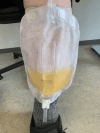Purple Urine Bag Syndrome: Antibiotic Treatment or Not?
- PMID: 40718263
- PMCID: PMC12292030
- DOI: 10.7759/cureus.86725
Purple Urine Bag Syndrome: Antibiotic Treatment or Not?
Abstract
Purple urine bag syndrome (PUBS) is a relatively rare phenomenon characterized by purple discoloration of the urine, catheter, and collection bag in individuals with indwelling catheters often colonized by specific bacteria. Although typically asymptomatic, it requires appropriate diagnostic evaluation and, in some cases, targeted treatment. We present a case study of an 81-year-old male with an indwelling urinary catheter who developed an uncomplicated, self-limiting case of purple urine bag syndrome. The patient exhibited the characteristic purple discoloration of the catheter tubing and collection bag, without accompanying systemic symptoms such as fever, dysuria, flank pain, or altered mental status. This case underscores the importance of recognizing PUBS as a benign condition in many instances, to avoid unnecessary diagnostic testing or antibiotic therapy, while still ensuring appropriate clinical evaluation to rule out potential underlying infections or contributing risk factors.
Keywords: antibiotic resistance; indwelling catheter; pubs; purple urine bag syndrome; urinary tract infection.
Copyright © 2025, Helmsdal et al.
Conflict of interest statement
Human subjects: Informed consent for treatment and open access publication was obtained or waived by all participants in this study. Conflicts of interest: In compliance with the ICMJE uniform disclosure form, all authors declare the following: Payment/services info: All authors have declared that no financial support was received from any organization for the submitted work. Financial relationships: All authors have declared that they have no financial relationships at present or within the previous three years with any organizations that might have an interest in the submitted work. Other relationships: All authors have declared that there are no other relationships or activities that could appear to have influenced the submitted work.
Figures
Similar articles
-
Purple Urine Bag Syndrome in End-Stage Renal Disease: Recognizing the Unexpected.Cureus. 2025 Jun 1;17(6):e85178. doi: 10.7759/cureus.85178. eCollection 2025 Jun. Cureus. 2025. PMID: 40600087 Free PMC article.
-
Purple Urine Bag Syndrome in a Bedridden Postmenopausal Woman.J Midlife Health. 2025 Apr-Jun;16(2):208-210. doi: 10.4103/jmh.jmh_221_24. Epub 2025 Jun 23. J Midlife Health. 2025. PMID: 40636842 Free PMC article.
-
A Case of Purple Urine Bag Syndrome (PUBS) in a Patient With a Chronic Indwelling Foley Catheter.Cureus. 2024 Aug 25;16(8):e67731. doi: 10.7759/cureus.67731. eCollection 2024 Aug. Cureus. 2024. PMID: 39318926 Free PMC article.
-
Types of urethral catheters for management of short-term voiding problems in hospitalised adults.Cochrane Database Syst Rev. 2004;(1):CD004013. doi: 10.1002/14651858.CD004013.pub2. Cochrane Database Syst Rev. 2004. Update in: Cochrane Database Syst Rev. 2008 Apr 16;(2):CD004013. doi: 10.1002/14651858.CD004013.pub3. PMID: 14974052 Updated.
-
Management of urinary stones by experts in stone disease (ESD 2025).Arch Ital Urol Androl. 2025 Jun 30;97(2):14085. doi: 10.4081/aiua.2025.14085. Epub 2025 Jun 30. Arch Ital Urol Androl. 2025. PMID: 40583613 Review.
References
-
- Abnormal urine color. Aycock RD, Kass DA. South Med J. 2012;105:43–47. - PubMed
-
- Abnormal urine color: differential diagnosis. Raymond JR, Yarger WE. South Med J. 1988;81:837–841. - PubMed
-
- Acute hepatic porphyrias: “purple flags”--clinical features that should prompt specific diagnostic testing. Anderson KE, Desnick RJ, Stewart MF, Ventura P, Bonkovsky HL. Am J Med Sci. 2022;363:1–10. - PubMed
-
- A unique case of purple urine: a case report and literature review. Aklilu AM, Avigan ZM, Brewster UC. Clin Nephrol. 2021;95:273–277. - PubMed
Publication types
LinkOut - more resources
Full Text Sources


